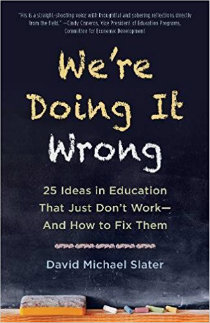25 Education Ideas That Don’t Work
We’re Doing It Wrong: 25 Ideas in Education That Just Don’t Work—and How to Fix Them
By David Michael Slater
(Skyhorse Publishing, 2018 – Learn more)

Believing that education is “a never-ending conversation,” David Slater begins his discussion of education problems by delineating 25 practices he believes we should change.
He also presents his credentials: he is a full-time middle school English teacher and has taught in a variety of settings for long enough to see “all manner of education ‘reform’ ideas come and go . . . and come back again—often repackaged with new names.” (He also writes books for teens and adults.)

Where bad education ideas come from
Slater’s introduction lays out four main reasons that wrong-headed ideas find their way into classrooms.
Reason #1 says: “When people with no training in education set education policy, bad ideas will find their way into classrooms.” He advises we look at the resumes of our local school board members. He contends that most won’t have a degree nor any practical experience in education.
Reason #2 is really the same idea but includes lawmakers whom he blames for forcing teachers to strive to have everyone reach the top, “which just can’t be done.”
Reason #3, according to Slater, is that teaching is viewed more as a science than an art. This results in the teacher being seen as a “replaceable factory worker.” This is why, he says, that teachers leave the profession in droves.
Reason #4 states that even when good ideas make their way to the classroom, there’s isn’t enough time to implement them properly.
A litany of problems
The first problem in Slater’s list of 25 is age-grouping. He believes if we grouped by “readiness,” not age, we would solve the problem of having to retain or pass a failed student. To avoid “tracking,” groups should be flexible and in nine-week blocks so they can be frequently adjusted as necessary.
In addition, children would be allowed to leave school at age sixteen if they complete requirements for a diploma early and especially if they want to enter the workforce. He does not say what students should do if they want to go to college and aren’t allowed in until they are 18.
He also believes after we’ve exhausted all means to keep students in school, we should let students drop out at 16 if they want to because “students not ready to learn, don’t learn.” However, he adds, students should be able to come back at any time of life. He believes this would show there is no shame in vocational careers. These policies would recognize that public schools cannot solve all of society’s problems, especially poverty.
Although a lot of arguments could be made as to why components of this solution wouldn’t work, Slater has courageously put forth a problem and solution to get us thinking and talking. And he acknowledges throughout the book that there is never a single solution to any problem.
Other problems cited by Slater include the teacher shortage, “Scripted” or “Canned” curriculum, merit pay, and attempts to remove teacher tenure. He contends that tenure only means you can’t get fired without due process. What he doesn’t acknowledge is how many years that due process can take while an ineffective teacher harms students.
Readers of this book will also discover why Slater thinks Student-Centered Instruction is not always a good practice and what teachers should be allowed to do instead. Should universities and schools think of their students as “clients”? And why haven’t we considered a law “requiring parents to pay legal costs if their suits are found to be frivolous”?
Slater also wants an end to professional development that wastes our time and is repetitive. Find out what he believes about how master teachers can best be used. In chapter 9, you’ll find his thoughts about the use “Charretes” in education, a marvelous idea.
The teacher reader will love Slater’s opinion on class size. Chapter 10 addresses the thorny issue of “differentiation.” Find out what he believes “reasonable differentiation” is and when it’s a “joke.” Although Slater has high hopes for Gifted Education in the future, he believes the gifted should be taught out of the regular classroom and quotes research as to why.
And more problems
When speaking of absent parents, mostly parents in poverty, he discusses the six types of poverty and why we should know parents’ particular situations. Chapter 15 discusses poverty and the number of homeless students (over 1.3 million in 2015!). Solutions include doing whatever we can to motivate the best teachers to take jobs in low-income schools, and exposing students to early literacy with interventions like First Book. Most importantly, communities need to work in partnership with their schools to close the “Opportunity Gap.”
As to grading in K-12 education, find out why Slater is an advocate of giving both an academic grade and also one for “Work Ethic,” “Behavior,” or “Life Skills.” Find out what he means by the “Badge System.”
Although Slater is a fan of group work, he admits assignments are often not well-designed and group participation should not always be required, considering introverts who prefer working alone. Group work should use team and empathy-building activities first.
Another problem is diversity education. How many teachers have been involved in only token efforts like having a “Diversity Week” or “Culture Fair” that simply reinforce stereotypes? His answer? We must promote cultural differences and demand tolerance of them. Except for giving a school climate survey, Slater is short on ideas here and only cites the National Education Association for resources. There are many more such as Teaching Tolerance and the Anti Defamation League which have full free curricula and lists of resources.
Slater is also short on solutions when he discusses the “pernicious” problem of bullying. The U.S. government says one in three students report being bullied. Then, alarmingly, Slater writes, “anti-bullying programs might actually teach bullies how to bully better.” He attributes this to messages like “it’s the victims’ responsibility to diffuse the situation,” and advice or policies that it is never acceptable to hit back.
I do like his suggestion that community adults should be all over campus, but in light of recent current events like the Florida shooting, Slater and all of us need to take a deeper look at this solution.
Slater believes we have a writing crisis. His solution? Teach forms and structures like the five-paragraph essay and let students find their own subjects of interest. I agree with this advice, but what about grammar and sentence structure? I do agree that English teachers’ class size loads must be reduced. Paper grading can make English teachers’ lives miserable and take all the joy out of teaching.
Idea #22 talks about how teachers are not enrolling in teacher training programs and the many reasons (general lack of respect, unmanageable workloads). His solution? Mentors for new teachers, raising starting salaries, forgiveness of college debt after teaching a certain number of years, and attractive home loans.
In the last part of the book, Slater takes on School Choice. He is not supportive of vouchers but suggests that charters, government-authorized schools run by private organizations, are one solution, in theory. He recognizes some arguments against charters, but in the end says they “can become incubators for cutting-edge education, but they must be 100 percent as transparent as traditional public schools and held every bit as accountable.” He is more in favor, however, of the public schools providing options in the form of electives, nontraditional grading, flipped classrooms and more.
A good place to begin
I agree with many of his suggestions and salute Slater’s honesty. Often he says what others won’t say. Often his “fixes” don’t go far enough. In the postscript, Slater acknowledges that our public school system is a “heroic institution” in its attempts to educate all children. He realizes there are many more issues to address but says if nothing else changes, our teachers need to be treated as professionals.
That would truly be transformative, and a good place to begin.
Dr. Mary Langer Thompson’s articles, short stories, and poetry appear in various journals and anthologies. After many years of teaching middle and high school English, she worked with hundreds of beginning and experienced California teachers as a “Clinical Consultant” at UCLA and as a public school administrator.





































It sounds really interesting! I’m attracted to the non-standard approach to the learning process.